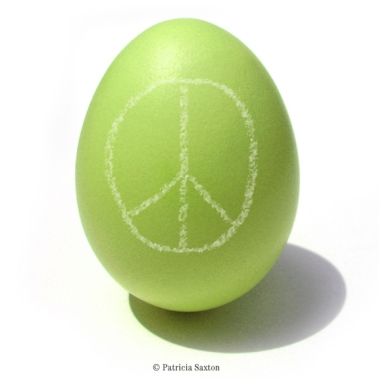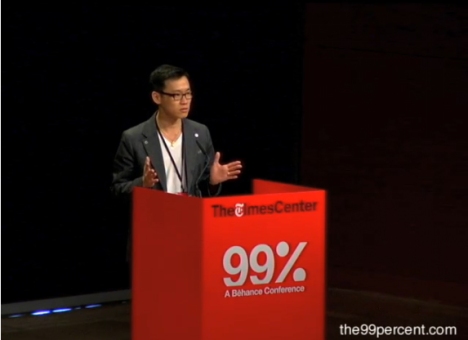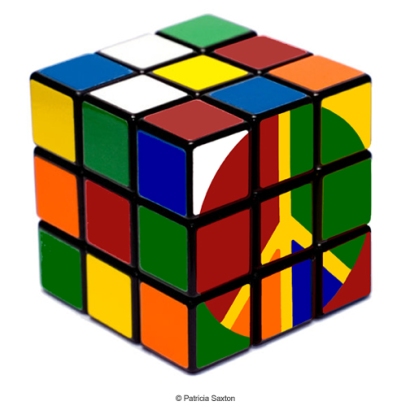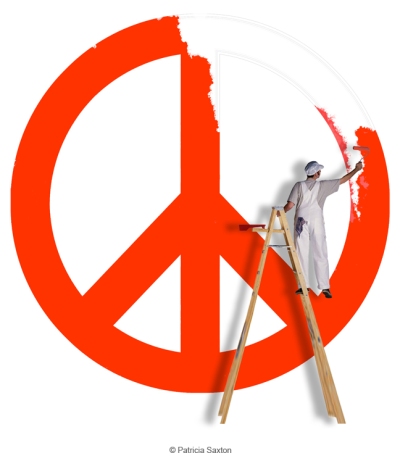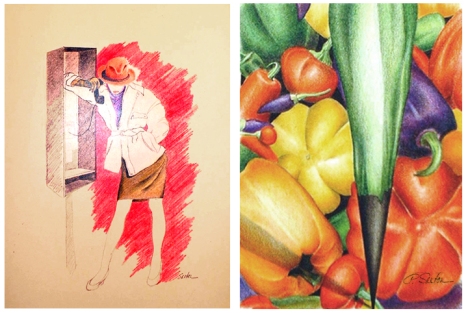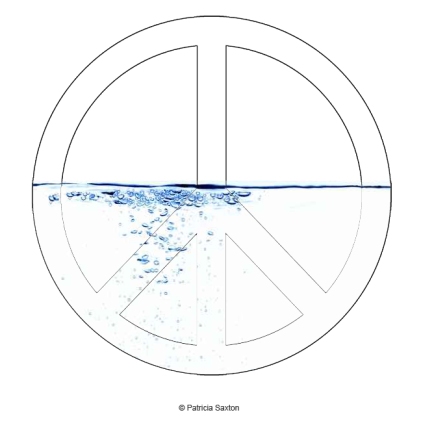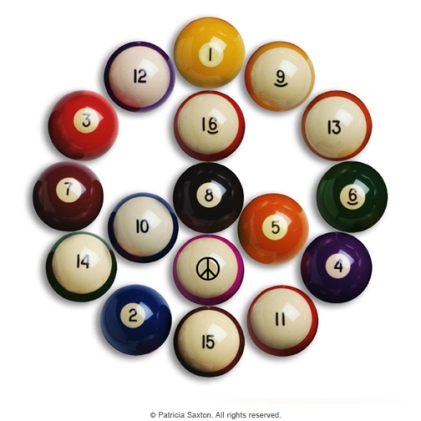The Power of Personal Projects
Ji Lee: The Transformative Power of Personal Projects
Inspiring talk from Ji Lee – now Creative Director of Google Creative Lab – about personal projects and their ability to transform your ideas as well as your career. From his own life experience of boredom resulting in an idea which turned viral and became a design phenomenon known as The Bubble Project”, Lee talks about how he created, financed, and marketed the project single-handedly, and how it ultimately forwarded his professional career. Featured on the 99% site, devoted to “making ideas happen”, and well worth visiting.
(NOTE: Unfortunately, the “embed this video” code didn’t work for me on this one! Instead, click on the image above to watch/ hear the video at the 99% site.)
Press Coverage for March 25th Art Opening of "The Many Faces of Eve"
A Women’s Intuition in Perth Amboy
By Ralph J. BellantoniCorrespondent
The Perth Amboy Gallery Center for the Arts celebrates Women’s History Month with the group exhibit “The Many Faces of Eve.” The show opened March 8 and the center will host a reception from 5:30 to 8 p.m. on Thursday, March 25.
The show presents work by Jamie Allen, Patricia Banks, Harriet FeBland, Gracelyn Molina, Amy Ortiz, Patricia Saxton, Adrienne Wheeler and curator Laura Cuevas. The artwork addresses issues of morality, sexuality, family, spirituality and self and social identity in an expansive diversity of styles and media. The light of the primal Eve refracts in resplendent display through the particular energy, talent and resourcefulness of each accomplished artist.
Cuevas’ own paintings and oil pastels straddle the abstract and figurative in her
depictions of bodies, fruits and foliages melting and blurring into sensual fields of color and texture. FeBland has been dubbed “the poet of geometry” because of her mathematically precise paintings, transformed through the intuitive prism of her creative imagination. Ortiz explores themes of the intertwined connection of women and nature through surreal compositions.
Wheeler’s work arises from ancestral and spiritual practices drawn from the Bakongo traditions of the Atlantic coast of Africa. She creates “Nkisi” (sacred medicine) — consisting of carefully assembled materials bundled into fetishes of spiritual potency. She created her installation in response to the recent earthquake that devastated Haiti.
In this composition, Wheeler’s Nkisi represent bundles of bodies, belongings, medicines, airlifted supplies and hope. She reminds people that Haiti has actually been in a state of devastation for centuries. She hopes her work can act as a catalyst for change — a plea for vigilance in bringing an end to the vicious cycles of global human suffering.
Saxton has been drawing and painting since early childhood. She has run her Saxton Illustration & Design firm for more than 20 years, and is author and illustrator of the children’s stories “A Book of Fairies’‘ and “The Book of Mermaids.”
“Somewhere around the age of 3, I picked up a pencil and never quite put it back down,” said the artist.
Saxton merges image and text, the real and imagined, in her fine art works in pen and ink, pencil and oils. She accentuates positives over negatives and seeks the nourishment of mind and soul through her art.
“I am particularly delighted to be a part of this unique exhibition and its diverse
collection of women artists honoring the feminine and the “many faces of Eve,”’ said Saxton.
THE MANY FACES OF EVE: GROUP EXHIBIT CELEBRATING WOMEN’S HISTORY MONTH
1 to 6 p.m.
Mondays through Saturdays
through April 30
Opening reception from 5:30 to
8 p.m Thursday, March 25
Perth Amboy Gallery Center for the Arts
399 Reade St., Perth Amboy
Free
732-826-8083 www.perthamboygallery.org
Week 29: "52 Weeks of Peace"
Oh, the music in the air!
An’ the joy that’s ivrywhere –
Shure, the whole blue vault of heaven is wan grand triumphal arch,
An’ the earth below is gay
Wid its tender green th’-day,
Fur the whole world is Irish on the Seventeenth o’ March!
~Thomas Augustin Daly
Guitar For The Ages
Audiences have long enjoyed his acoustic prowess “live” – but I am just so pleased to share this taste of David Saxton’s amazing talent more broadly now, via video. His sound is a little bit Leo Kottke and a touch of Michael Hedges ~ but he’s entirely his own. Composing since his teens, Dave makes music that’s rich, melodic, stirring and deceptively complex. Enjoy!
The Joy of Being a Dog
This is just a great piece of advertising. Pure joy too.
Week 28: "52 Weeks of Peace"
Paint your world.
Drawing Tips: Colored Pencil
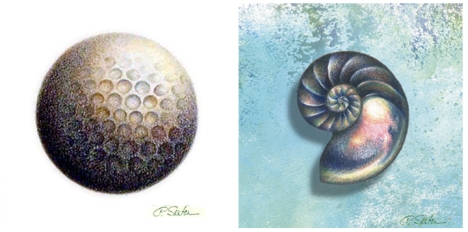 Colored pencils are one of my favorite mediums. They’re also one of the most unforgiving, as a friend recently discovered.
Colored pencils are one of my favorite mediums. They’re also one of the most unforgiving, as a friend recently discovered.
My friend’s son, a budding artist, had apparently drawn an amazing picture, then decided to color it in with colored pencils. But he “hated what he did” and wanted to erase the color. She asked me if there were an amazing eraser out there that would solve the problem – or if he was doomed to start over.
My short answer was that there is no “amazing eraser” for colored pencil, and that yes, he was most likely doomed.
So maybe you too have decided to try illustrating with colored pencils. You’ve got your base drawing down and now you’re coloring away, shading, blending, watching the colors come to life. Time passes without notice.
Then in one dreaded moment, you realize you’ve gone too far. You reach for your eraser. You erase…. nothing happens. You try again. You curse. Maybe you scream. But you pull yourself together, because you think, ha! – there’s gotta be a solution. It’s just pencil, after all.
Not to dash your hopes, but here’s the harsh reality: Unless you’ve used your colored pencil v-e-r-y lightly (in which case you haven’t gone too far, so there’s been no cause for dread), you – just like my friend’s son – are probably, almost definitely, doomed to begin again.
There are people who use an electric eraser, or an eraser that sharpens like a pencil, but these take practice (otherwise they smear or eat the paper), are meant for small areas, and can be more frustrating than starting over. White artist erasers or gray putty erasers, which I personally love for regular pencil, don’t do the trick with colored pencils, only taking off slight upper layers of shading.
Aside from starting over, another option is to turn your mistake into something else – sometimes a mistake offers a new way to think about your picture. But once you’ve laid down a bunch of color, erasing is not a viable option.
The real lesson here of course, is about going slowly…. before it’s too late to go back! And that making a sketch first (even a rough one) to test out the color is a real smart thing to do.
You can also lay a piece of tissue paper over the drawing and color over it (on the tissue paper), to get an idea of how the color might look – just keep in mind that the texture of the tracing paper creates a different feel, and that colored pencils will behave differently on drawing paper. But this simple step can let you know whether you want to forge ahead with color at all.
And like anything else, the more practiced you become, the more skilled and confident you’ll be, and those mistakes won’t be such a concern.
Week 27: "52 Weeks of Peace"
Part intention, part belief… peace is a place that dwells somewhere inside us all … beneath the fray, outside the chatter, standing at the edge of chaos … stored in elements both real and imagined … and always a little bit magical.
Week 26: "52 Weeks of Peace"
“Half-Full”
26 weeks marks the series’ midpoint – and the idea of “halfway” turned into “half-full/half-empty” … which, of course, leaves room for personal interpretation, so I’ll just leave it at that for now.
Week 25: "52 Weeks of Peace"
Peace Break
"On Love"
Valentine’s Day.
What better time than this to hear once again the words of the great philosophical master, artist and poet, Kahlil Gibran, “On Love”…
When love beckons to you, follow him,
Though his ways are hard and steep.
And when his wings enfold you yield to him,
Though the sword hidden among his pinions may wound you.
And when he speaks to you believe in him,
Though his voice may shatter your dreams
as the north wind lays waste the garden.
For even as love crowns you so shall he crucify you. Even as he is for your growth so is he for your pruning.
Even as he ascends to your height and caresses your tenderest branches that quiver in the sun,
So shall he descend to your roots and shake them in their clinging to the earth.
Like sheaves of corn he gathers you unto himself.
He threshes you to make you naked.
He sifts you to free you from your husks.
He grinds you to whiteness.
He kneads you until you are pliant;
And then he assigns you to his sacred fire, that you may become sacred bread for God’s sacred feast.
All these things shall love do unto you that you may know the secrets of your heart, and in that knowledge become a fragment of Life’s heart.
But if in your fear you would seek only love’s peace and love’s pleasure,
Then it is better for you that you cover your nakedness and pass out of love’s threshing-floor,
Into the seasonless world where you shall laugh, but not all of your laughter, and weep, but not all of your tears.
Love gives naught but itself and takes naught but from itself.
Love possesses not nor would it be possessed;
For love is sufficient unto love.
When you love you should not say, “God is in my heart,” but rather, “I am in the heart of God.”
And think not you can direct the course of love, for love, if it finds you worthy, directs your course.
Love has no other desire but to fulfill itself.
But if you love and must needs have desires, let these be your desires:
To melt and be like a running brook that sings its melody to the night.
To know the pain of too much tenderness.
To be wounded by your own understanding of love;
And to bleed willingly and joyfully.
To wake at dawn with a winged heart and give thanks for another day of loving;
To rest at the noon hour and meditate love’s ecstasy;
To return home at eventide with gratitude;
And then to sleep with a prayer for the beloved in your heart and a song of praise upon your lips.
~ Kahlil Gibran
Your Life Story in Six Words
This just might get your creative juices flowing. Or at the very least, chop away at some of life’s mental riff-raff when you consider: What really matters? What are you truly about? How much story can be packed into 6 words? How much punch?
You’d think we’d all be experts, afloat as we are in a sea of restless soundbites and twitter-clips. But it’s not as easy as it might seem…
Below is an excerpt from Feb. 3 NPR , Can You Tell Your Life Story In Exactly Six Words?
Once asked to write a full story in six words, legend has it that novelist Ernest Hemingway responded: “For Sale: baby shoes, never worn.”
In this spirit, Smith Magazine invited writers “famous and obscure” to distill their own life stories into exactly six words. It All Changed in an Instant is the fourth collection of very, very brief life stories from Smith. The tiny memoirs are sometimes sad, often funny — and always concise.
It All Changed in an Instant is full of well-known names — from activist Gloria Steinem (“Life is one big editorial meeting”), to author Frank McCourt (“The miserable childhood leads to royalties”), to actress Molly Ringwald (“Acting is not all I am”).
Larry Smith, founding editor of Smith, and Rachel Fershleiser, Smith‘s memoir editor, talk to NPR’s Rebecca Roberts about the fun and the challenge of capturing real-life stories in six little words.
Smith’s six-word memoir? “Now I obsessively count the words.” And Fershleiser’s: “Bookstore to book tour in seconds.”
Can you write your autobiography in one sentence?
………………………………………………………………
Gets you thinking, huh. Can you do it? Are you willing to share yours? (I’m still thinking…)



